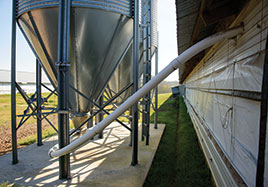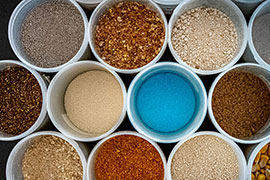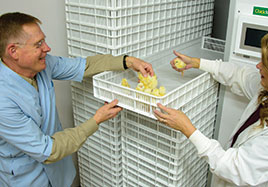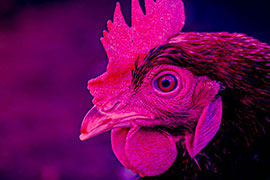Research
Publications | Mississippi Agricultural and Forestry Experiment Station | Facilities
The Department of Poultry Science conducts research on the complete life cycle of poultry from the egg through the adult bird. Scientists conduct experiments to improve poultry processing and the quality of meat. Other studies examine feed alternatives, vaccines and bedding materials. Researchers also study game bird species.
Distillers' Grains as a Feed Supplement

Down the Line

730 million broilers were raised on Mississippi farms in 2015. MAFES researchers hope to discover more efficient, cost-effective ways to deliver feed to so many birds. That's why Dr. Kelley Wamsley, MAFES researcher and assistant professor in the Department of Poultry Science, is studying how feed mill mechanics affect feed quality. Former MSU graduate student Ben Sellers conducted much of the research and Chris McDaniel, professor in the Department of Poultry Science, assisted on the projects. Read more
Enriched Formulations

Dr. Kelley Wamsley, associate professor in the Department of Poultry Science and MAFES scientist; Courtney Ennis, Wamsley's doctoral student; and Dr. Curran Gehring, a nutritionist with Tucker Milling LLC, collaborated on studying ways to improve the nutritional performance of commercial poultry feed. Starting in 2019, the team investigated phytase enzymes, one of the most common exogenous enzymes used in commercial poultry feed. Collaborating with phytase companies, the team wanted to discover where different enzymes could work in combination and in other parts of the GI tract to capture as much phosphorus as possible. Birds do not digest all the nutrition they take in, which is why enzymes are added to the feed to increase digestibility to make more nutrients available. The team found a gap in the field's knowledge, which is the combined use of varying phytase enzymes. In two different experiments, they found that a diet in low calcium and available phosphorus with a high level of a single phytase resulted in improved broiler performance and nutrient digestibility. The team uncovered the need to further research on how the ratios of calcium and available phosphorus in feed can impact the efficacy of phytases. Wamsley plans to take these studies further and look at other enzymes to determine whether there is a synergistic effect on the nutrients in poultry feed. Read more
MSU researches poultry health, growth

Q&A with David Peebles

Poultry was a $3.2 billion dollar business in Mississippi in 2015. MAFES scientists conduct research that drives that industry forward. One such researcher is Dr. David Peebles. He's a MAFES scientist and professor in the Department of Poultry Science in the College of Agriculture and Life Sciences. He's called Mississippi State home for 35 years. Much of his research has been applied directly to the poultry industry while all of his students gain employment in their field of study. MAFES Discovers sat down with Peebles to discuss how his research role helps inform the poultry industry and discover how his academic appointment helps grow the poultry leaders of tomorrow. Read more
Science that Illuminates

Dr. Pratima Adhikari, assistant professor in the Department of Poultry Science and MAFES scientist, and Ishab Poudel, current doctoral student in the Department of Poultry Science, along with other MAFES researchers conducted a two-year study that analyzed the impact that red- and blue- LED light environments had on chickens during developmental stages of growth. The scientists assessed how both blue- and red-LED lights affected bird behavior and stress response. They found that a blue-LED light environment was beneficial during the developmental phases of the birds and resulted in higher body weight, which also resulted in earlier reproductive maturity. With the red-LED light environment, administered during the laying phase, scientists found a higher egg yolk percentage. Scientists also concluded that alternative lighting did not have an impact on health or stress and that serum melatonin levels and serum corticosterone levels were not affected by light difference. Read more
Scientists Develop New Processing Technique

Treatments to Reduce Bacteria

Quick Links
- Majoring in Poultry
- Schedule a Visit
- Locate Us
- Apply Online
- Make a Gift
- Alumni and Friends
- The Industry
Defend Your Flock!
Find out the latest information on
Avian Influenza.



